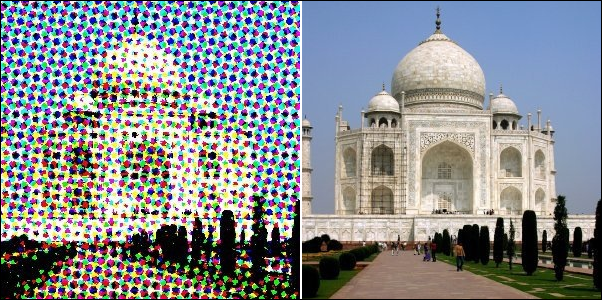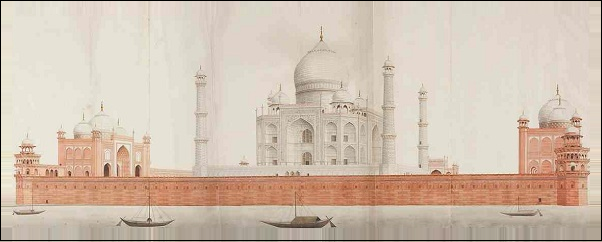Connect the Dots … see the Big Picture
[ cross-posted from Zenpundit — bragging on Cath Styles and our joint game project, Sembl, via the Taj Mahal ]
.
Okay, I cheated: the image on the left is a modification of the image on the right using GIMP, the GNU Image Manipulation Program — but you get the idea — printed images in newspapers used to be done in halftone dots, which when magnified looked like the image on the right, and when seen from regular viewing distance like that on the left. You get my point.
When there’s talk of “solving analytic puzzles”, though, the issue is often phrased in terms of “connecting the dots” to “see the big picture”.
When the “dots” are nuggets of data, information, knowledge, or even god help us wisdom, however, the way to connect them for the most powerful overview is by means of a “creative leap” from one datum to the next — and such a leap, when you think of it, boils down to a primitive element of pattern recognition: this is like that, this sembles that.
In this introductory video on Sembl, Dr Cath Styles puts what we’re up to nicely:
Sembl from Catherine Styles on Vimeo.
Key quote:
Sembl generates a trove of unique analogical data, and if that data is linked to logical data about concepts, people and places, Sembl will connect our intuitive understanding of how things are like each other with our rational knowledge of what things are. We’re building a new kind of index to the global network, harnessing the associating capacity of humans and the processing power of machines. so we can surface useful, relevant information from masses of available data. It’s browse and play in the service of find and resolve…
Let’s bullet-point that. It’s not the only way to describe Sembl, but it’s a very concise and useful one. We are:
generating a trove of unique analogical data building a new kind of index to the global network connecting our intuitive understanding with our rational knowledge surfacing useful, relevant information from masses of available data harnessing the associating capacity of humans and the processing power of machines
And we’re doing that in depth, in a style that calls forth artistry…
Isaac Bashevis Singer‘s artist’s eye sees connections that are more mystical and less obviously practical than the ones you and I see — in his short story, A Piece of Advice, for instance:
Nowadays snow is a trifle: it falls for a day or two at most. But in those days! Often it snowed for a month without stopping! Huge snowdrifts piled up; houses were buried; and everyone had to dig their way out. Heaven and earth merged and became one. Why does the beard of an old man turn white? Such things are all related. — at night, we heard the howling of beasts . . . or perhaps it was only the sound of the wind.
— but then Isaac Bashevis Singer has a Nobel Prize for this sort of thing — while for almost all values of you and I, you and I don’t as yet, and maybe never will.
Here’s what an artist’s eye makes of the Taj Mahal:



Leave a Reply
Want to join the discussion?Feel free to contribute!